Seakeeper Ride | Commissioning Instructions
Seakeeper Ride | Commissioning Instructions
1. Introduction
Updated 10/25/2023
Following installation, the Seakeeper Ride system must be configured prior to operation. This process is performed by the Original Equipment Manufacturer (OEM/boat builder) or a professional Seakeeper certified installer if they performed the installation.
Note: Scan the QR code below to access Seakeeper Ride BILT 3D instructions. BILT App will assist in familiarization with the Seakeeper Ride components and includes a specific section for commissioning.
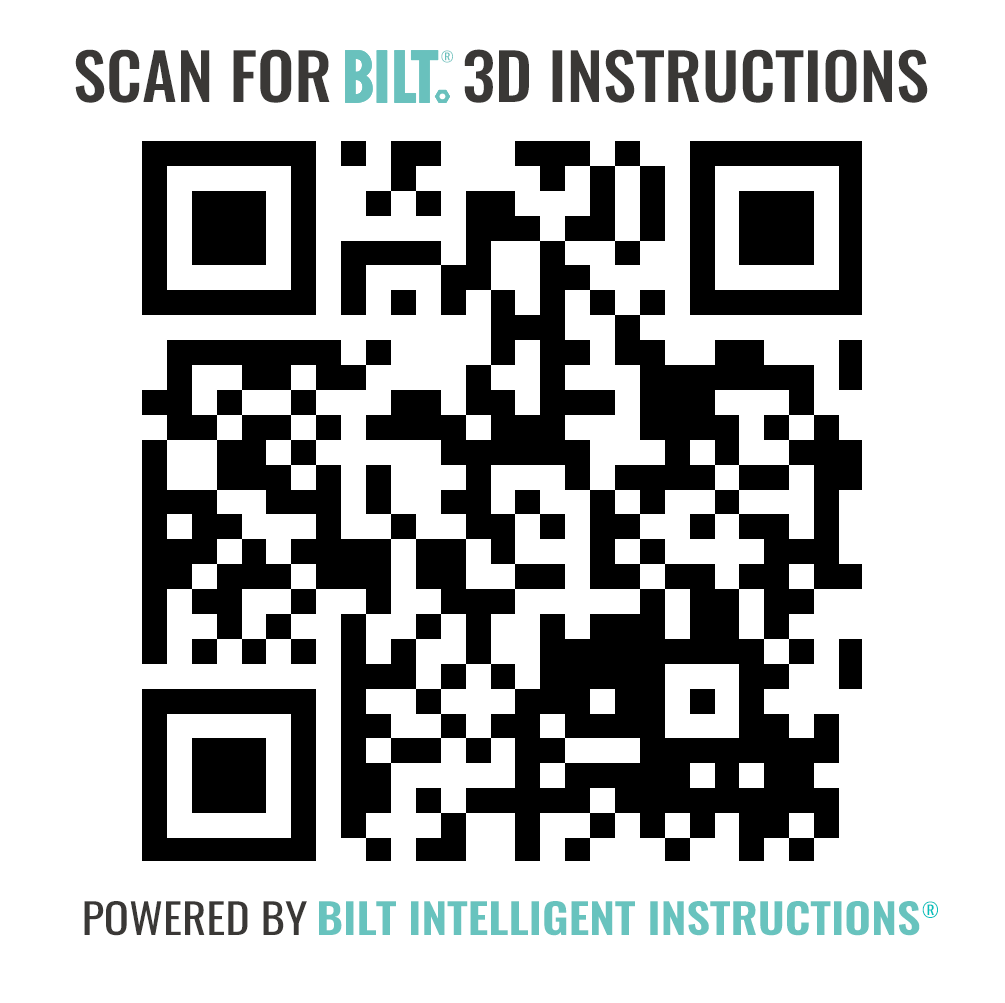

ATTENTION! Changing these critical settings can render the system non-functional and create an unsafe operating condition. Please proceed only if you have read and understand this manual in full.

ATTENTION! Advanced Mode configurations should only be changed under extenuating circumstances, such as replacing system components or if an incorrect calibration has been confidently diagnosed.
For Seakeeper Ride systems installed by end users, follow the steps below to commission your new system. The full procedure should take approximately 10 minutes if the boat is in a proper location before starting.
After following both the Mechanical and Electrical installation instructions, begin commissioning by ensuring the following:
- The boat is on an even keel (level port to starboard)
- The boat is trimmed level (no excess bow down or stern down angle)
- GPS has consistent satellite signal
- You have access to Controllers (If the boat is in the water this may not be possible, and therefore the boat may need to be trailered for the full procedure)
- You are aware of the cable side of the Actuators (example: port side Actuator Cable is in the port cable entry)
- You have access to the Distribution Module for unplugging and re-plugging in Controllers
- You have access to the MFD and optional Keypad
- You have access to circuit breakers
- You have access to the engine key switch
- No unnecessary persons are on the vessel
2. Software Module Switches
For Seakeeper Ride to connect properly to the Multifunction Display (MFD), the switches on the Software Module must be in the correct positions. Access the switches by removing the rubber covering on the upper left side of the Software Module.
Do not move Switch 2. Follow the table below to configure Switch 1 based on the MFD brand. The ‘on’ position is to the left.
| Garmin, Raymarine, Furuno | Switch 1 Off |
| Simrad, Lowrance, B&G, | Switch 1 On |


3. First Installation
The following instructions are for Software Version 2023.9.1 and newer. If you have older Software, please update as soon as possible by downloading and following instructions here. https://ride.seakeeper.com/support/software-updates/
If you cannot update your software, please go to Section 5 (Enter Advanced Mode) for step-by-step instructions on Commissioning older Software.
The Advanced Mode, shown below, will remain available for users that have updated their Seakeeper Ride system prior to September 1, 2023. The following steps shown will show the new Seakeeper Ride User Interface if the system has been updated after September 1, 2023. (Software 2023.9.1 or newer)
The following steps show the order in which Seakeeper Ride performs its set-up for Commissioning with the update after September 1st, 2023.
These settings all must be entered and completed in preparation for using Seakeeper Ride. The following information details each system status screen item, what they mean and how they affect the Seakeeper Ride system.

ATTENTION! Changing these critical settings can render the system nonfunctional and create an unsafe operating condition. Please proceed only if you have read and understand this manual in full.
Please read the prompts in each screen and follow the instructions presented on your MFD within the Seakeeper Ride app.
Welcome

Software Version
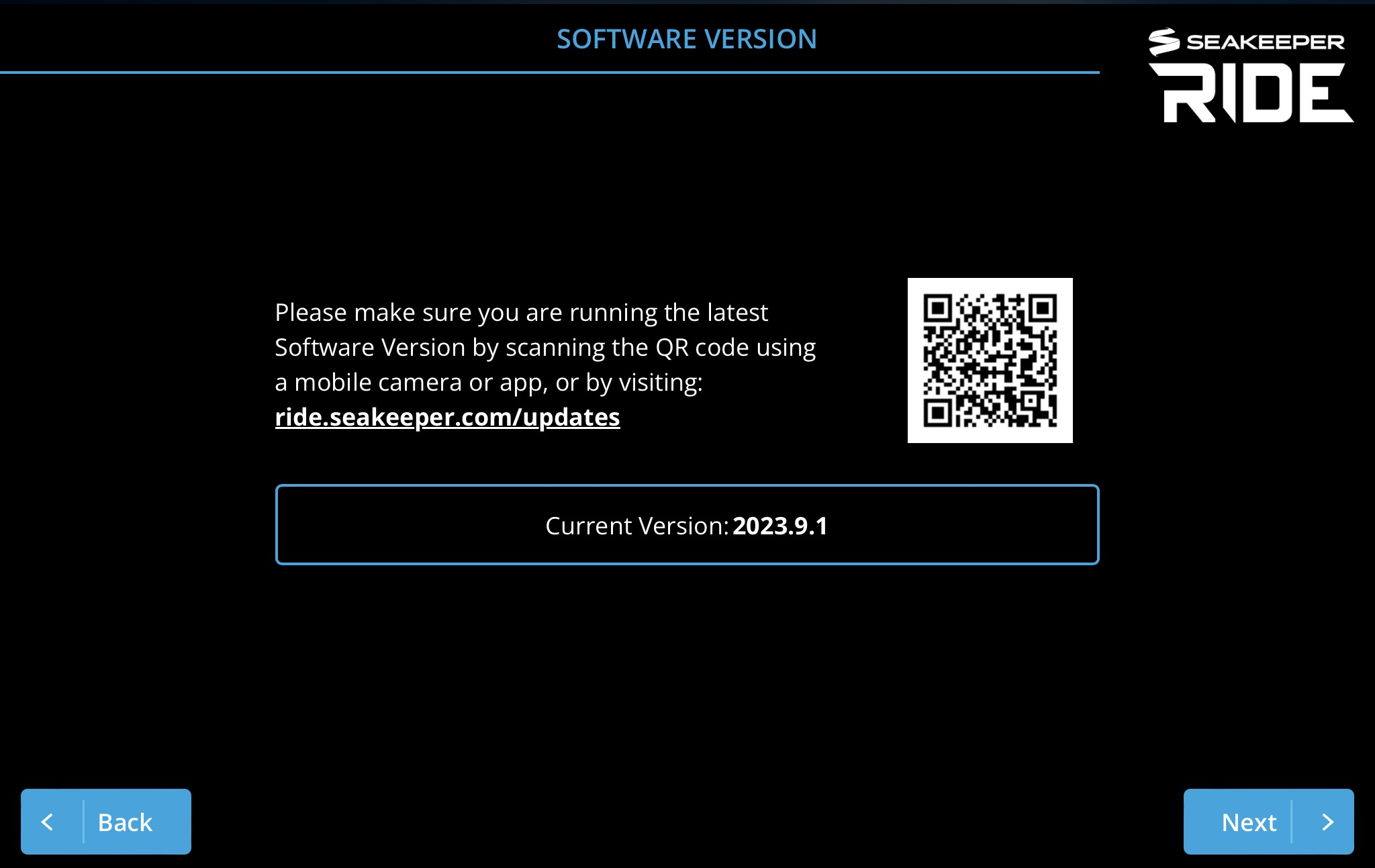
Install Instructions
Note: Boat must be stopped when performing install instructions.
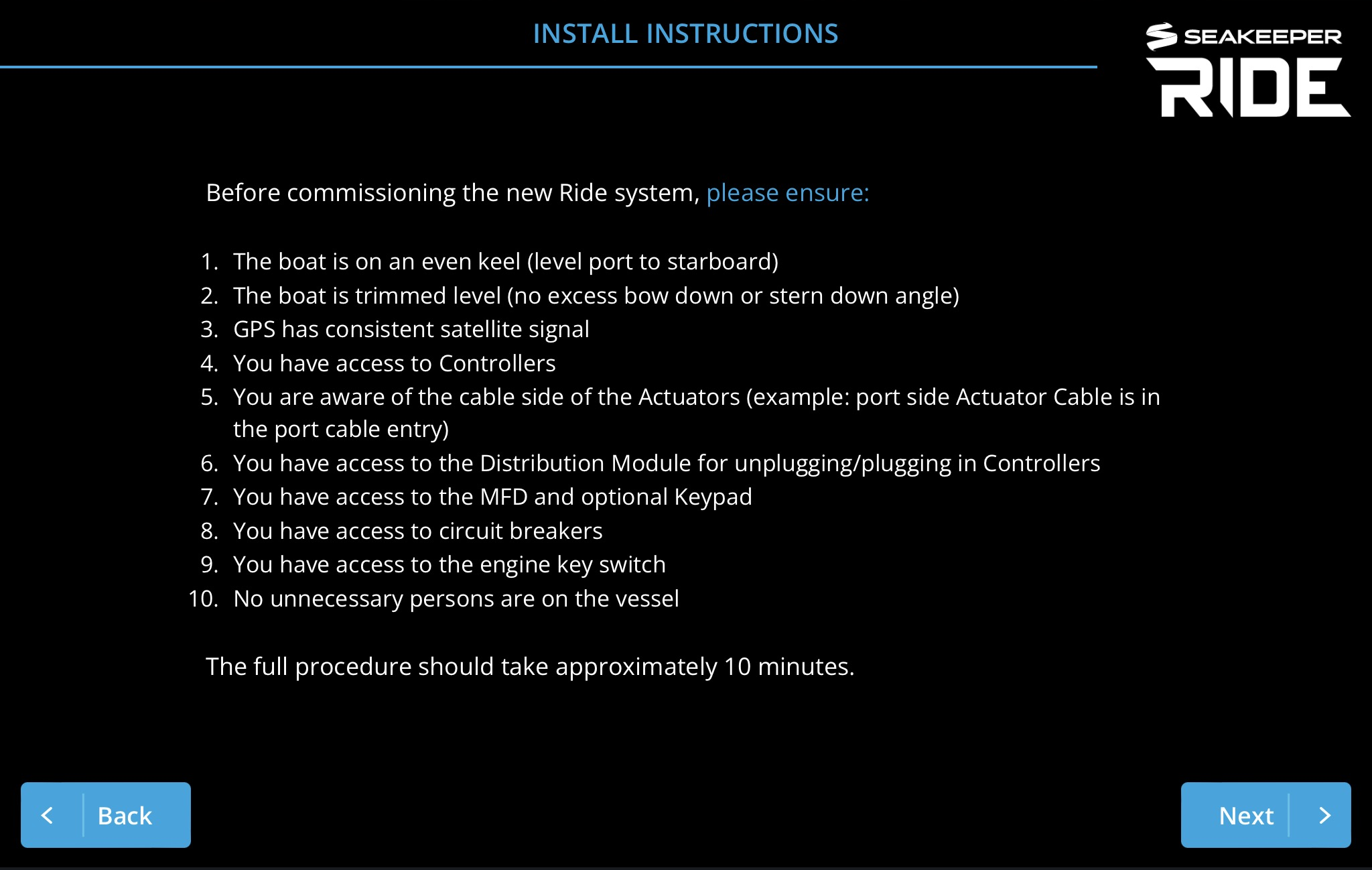
System Validation
This step ensures all components are updated to the latest software and may take a few minutes.
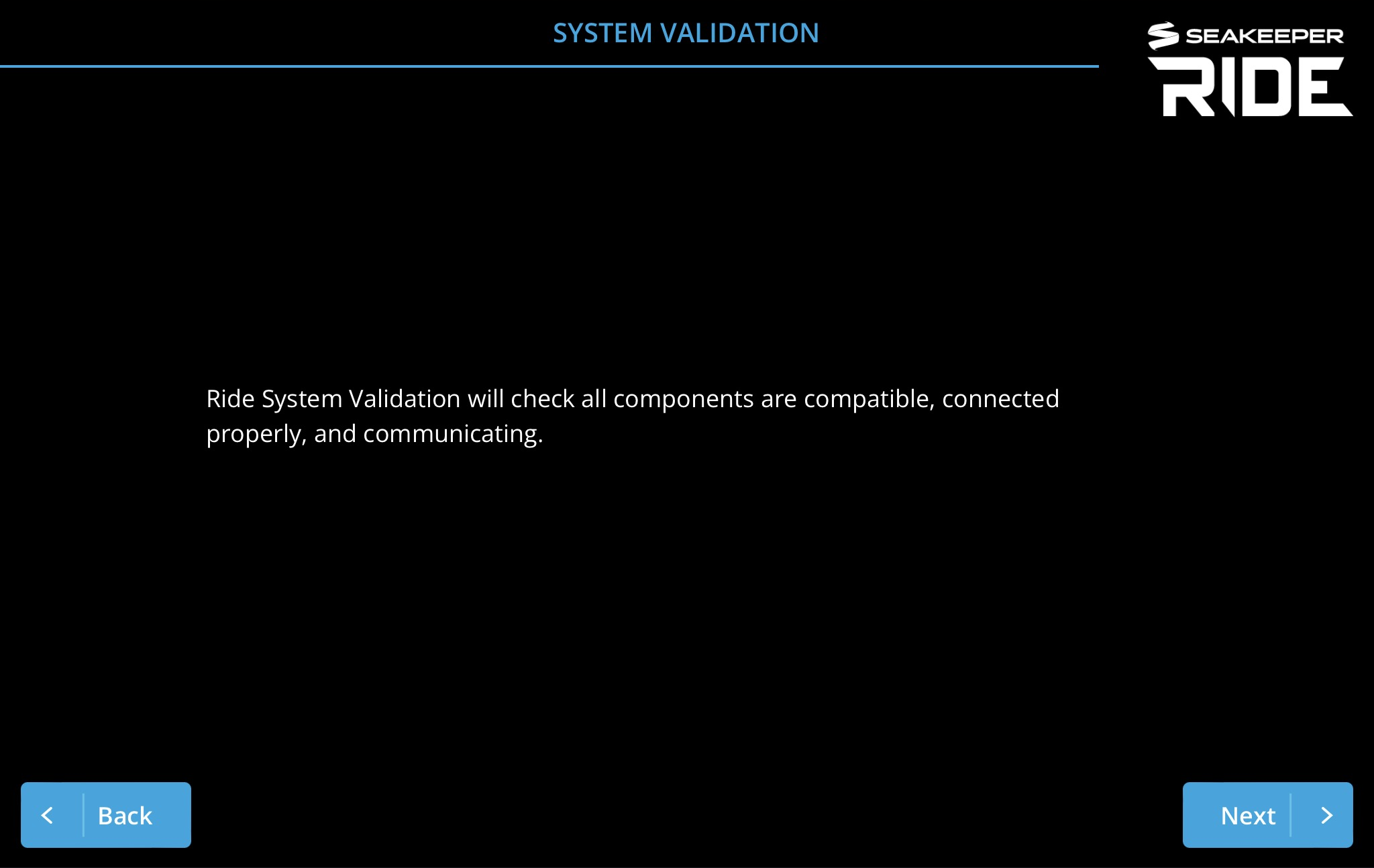
Software Module Orientation

WARNING: Software Module Orientation mounting position and selection is critical to safe operation of your boat. Incorrect mounting and orientation selection may result in unsafe boat handling. If you have any doubts or questions regarding this step, contact Seakeeper Ride Customer Support.
The Software Module Orientation allows the user will choose between the two possible mounting positions “STERN” or “BOW.” The Software Module senses the boats motions and is a critical piece of the installation. This selection will align the boat motion with the Seakeeper Ride components and correctly control your boat’s attitude. Visual confirmation of the Software Module’s location on board should be done at this step to ensure correct positioning on the boat.
Note: Please review the Electrical Installation Manual (Seakeeper Ride | Electrical Installation Manual) and BILT App QR code (below) for precise details on the Software Module location for best performance.

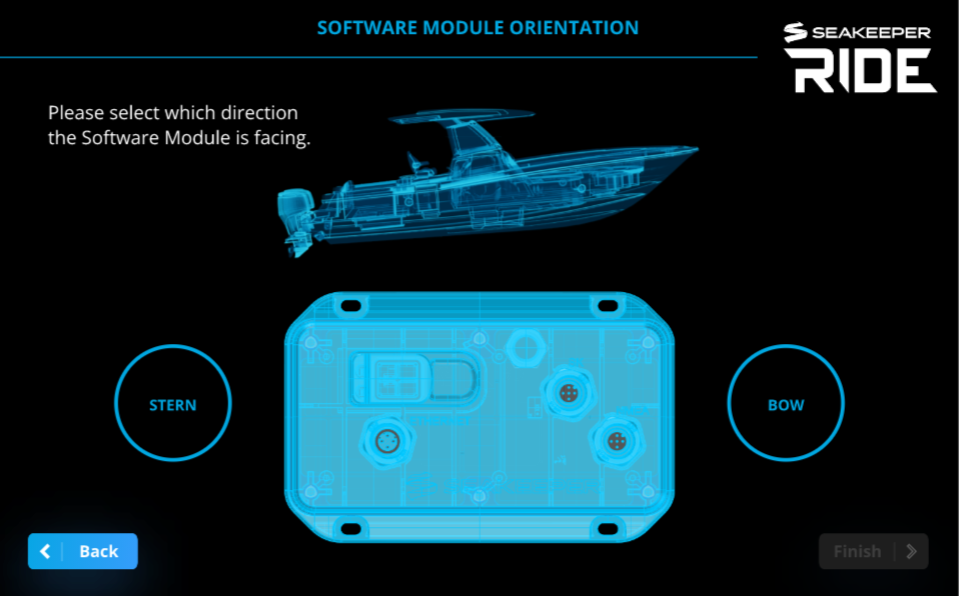
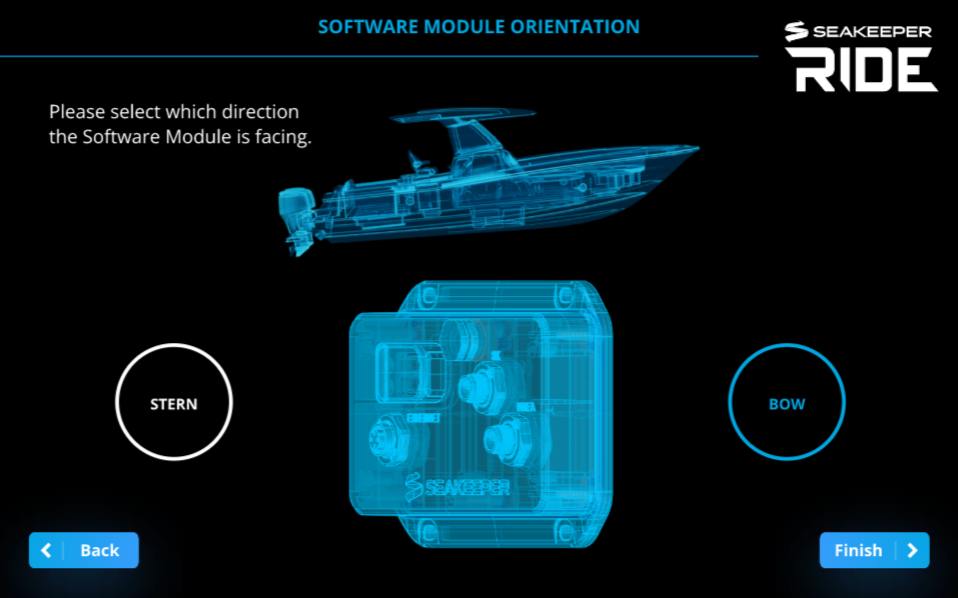
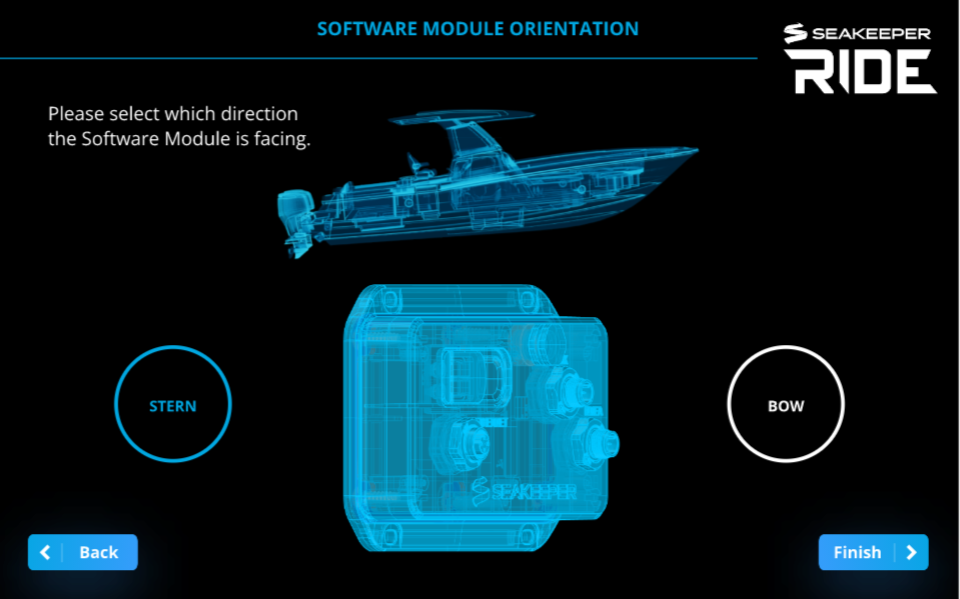
Controller Configuration
This step will assign the location, orientation and zero position for each Controller.
The on-screen prompts for Controller configuration will have you start with both Actuators unplugged from the Distribution Module. Plug in the Port Side Actuator cable to the Distribution Module and select the Port Controller Cable Routing.
Note: Due to engineering efforts to make the Seakeeper Ride equipment more versatile for ease of installation, the Controllers must follow a Configuration procedure that tunes them for proper operation. This requires the first-time installation to determine the location of the Controller, the cable side of the Controller and the zero position of the controller. Before proceeding you will need to know which cable end belongs to which Controller (which cable end is Port side and which cable end is Starboard side). You will also need to know how the Actuator is mounted within the Controller. It can be flipped 180 degrees in order for the cable to be routed as Port or Starboard to avoid hull structure or obstacles when pulling the cable from the actuator to the Distribution Module.
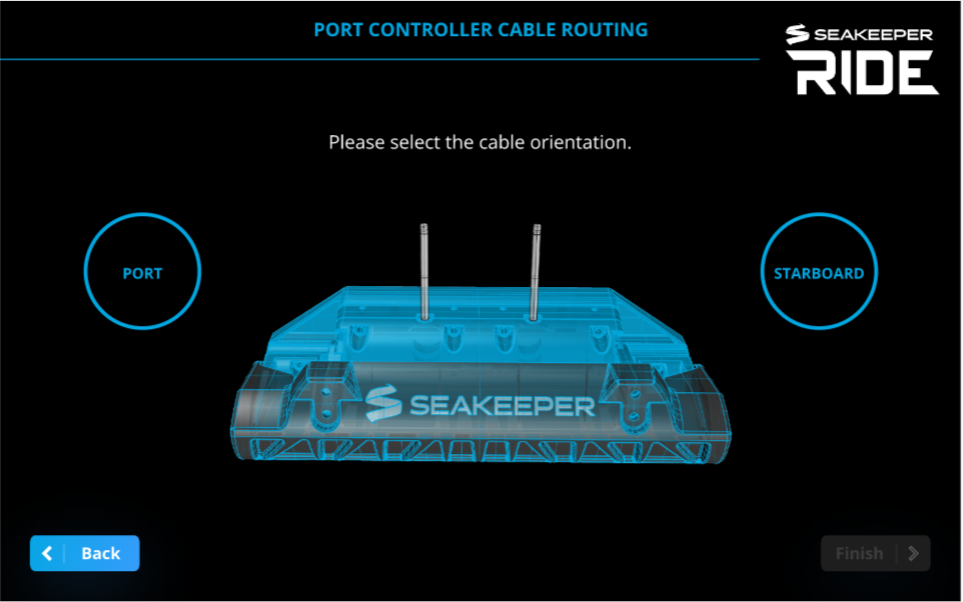
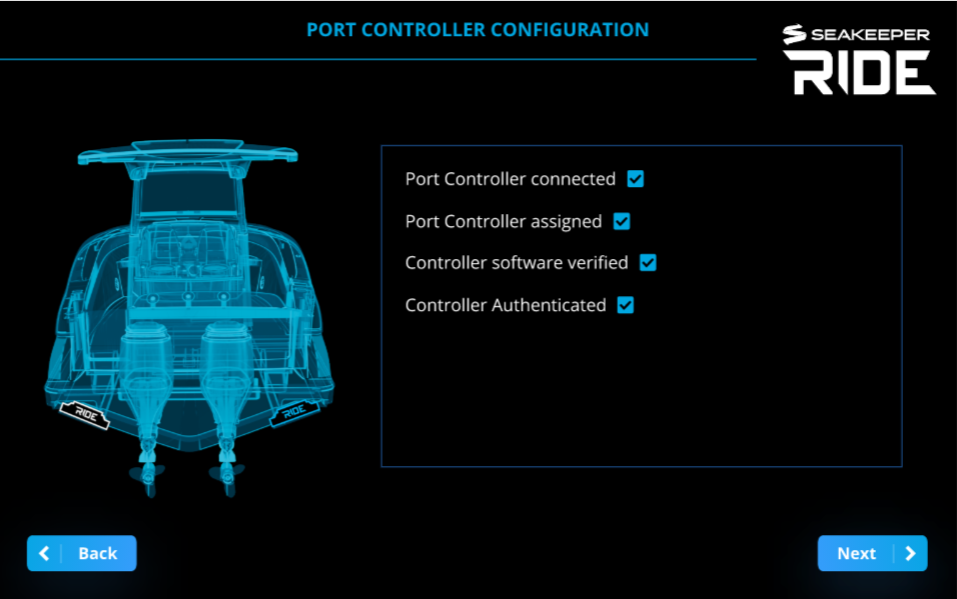
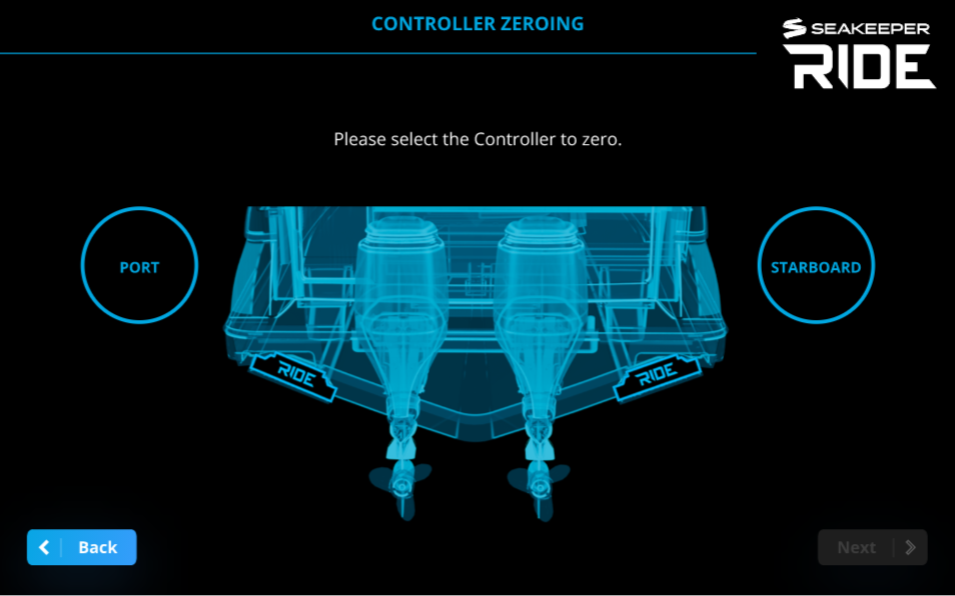
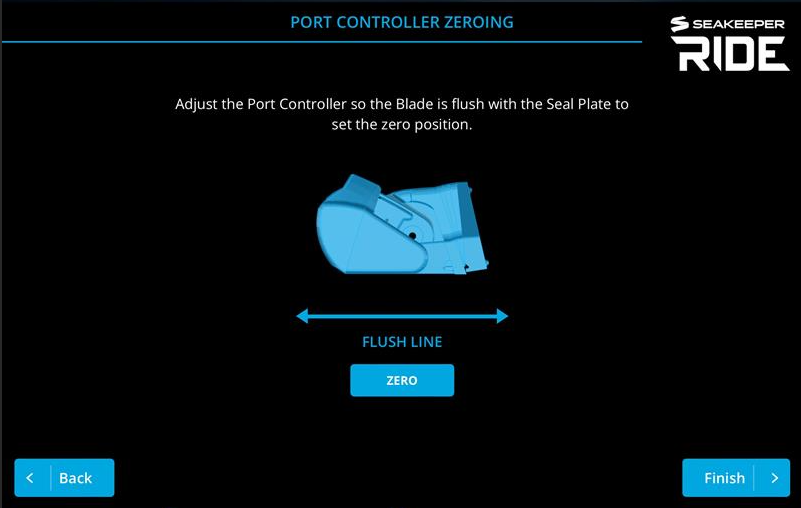
Plug in the Starboard Actuator so that both Cables are plugged into the Distribution Module.
Note: Follow installation wizard to configure Starboard Controller.
Diagnostics

WARNING: Diagnostic’s functions do not observe vessel speed, DO NOT attempt to perform Diagnostics when vessel is moving!!
Note: Vessel must be stopped when performing Diagnostics.
Diagnostics tests the mechanical travel, direction of motion, and communication of the Seakeeper Ride system prior to sea trialing. Please pay attention to which Controller side (Port or Starboard) you are diagnosing, so the movement of the controller matches the indicated movement on the Ride App Screen
Note: Diagnostics will be completed twice to check that both Actuators are functioning correctly. If your system has a keypad, the lights will not function during Diagnostics.
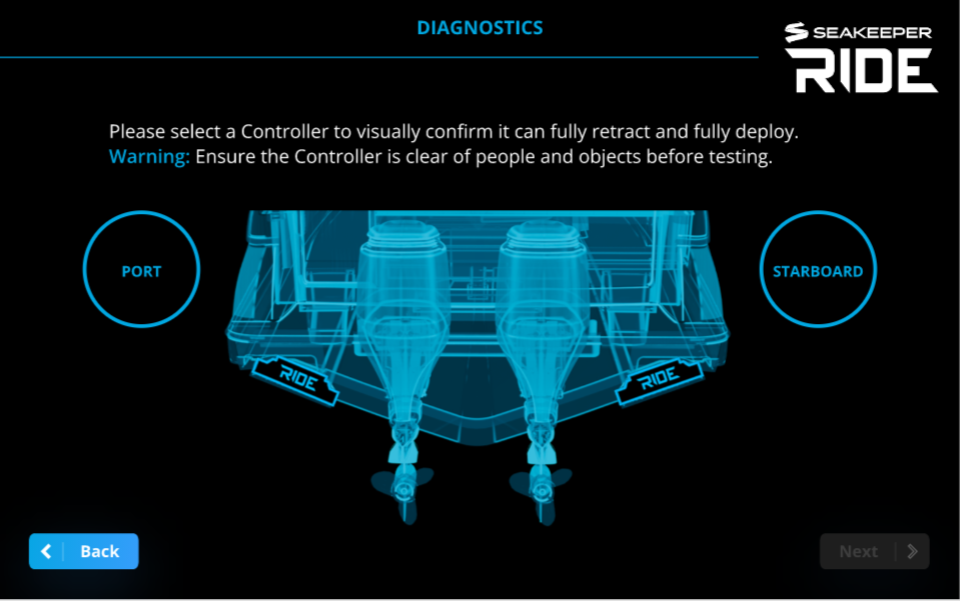
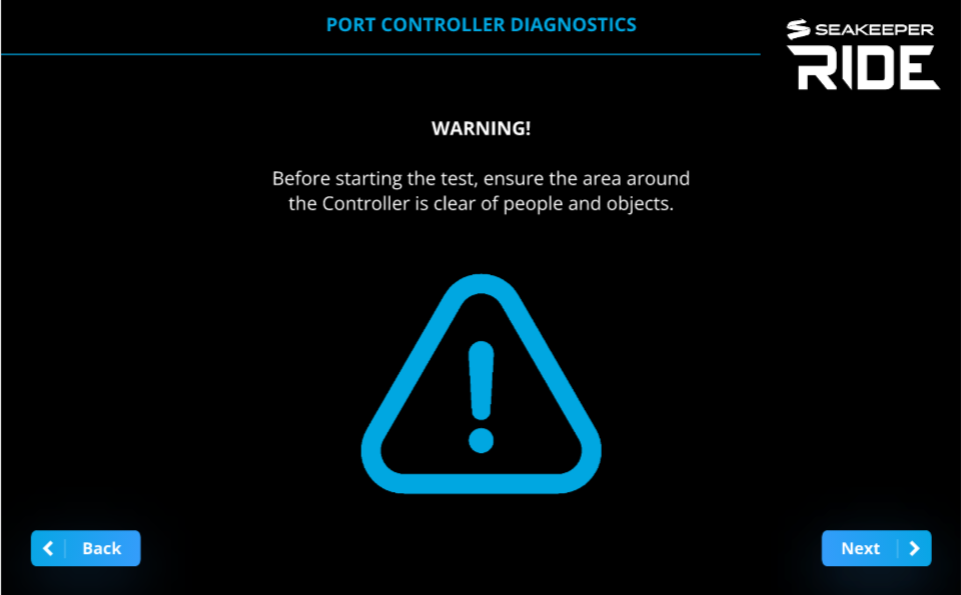
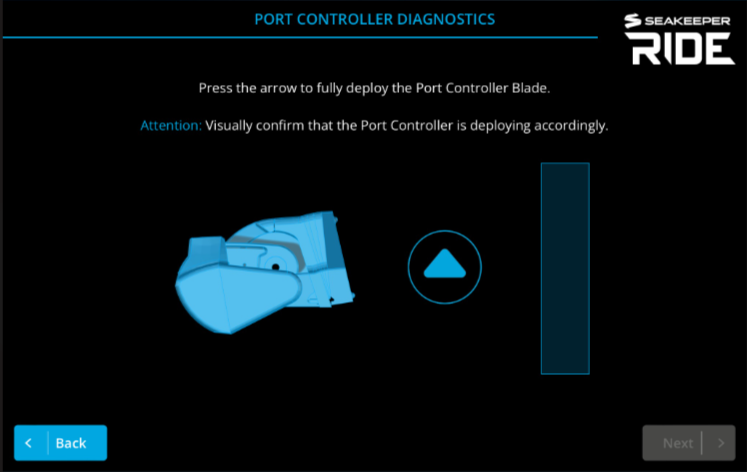
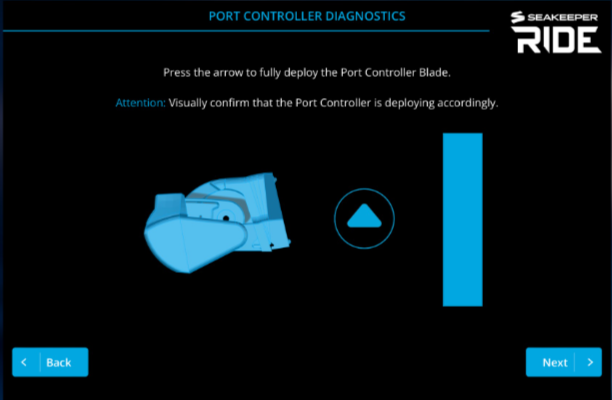
Note: In order to proceed you MUST achieve full deployment in order to select the ‘Next’ button.
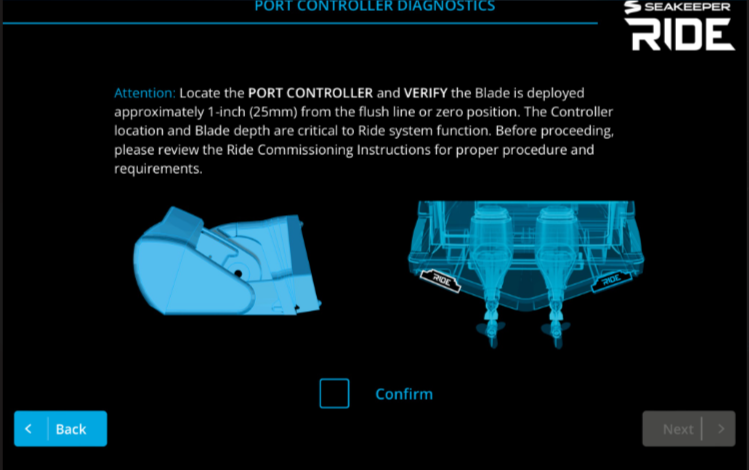
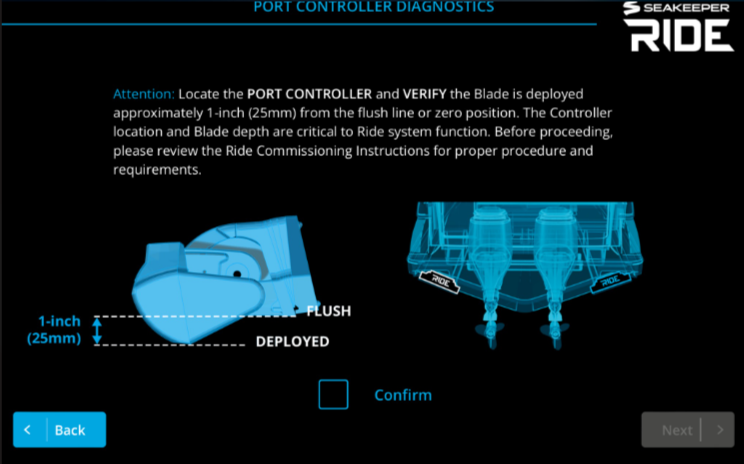
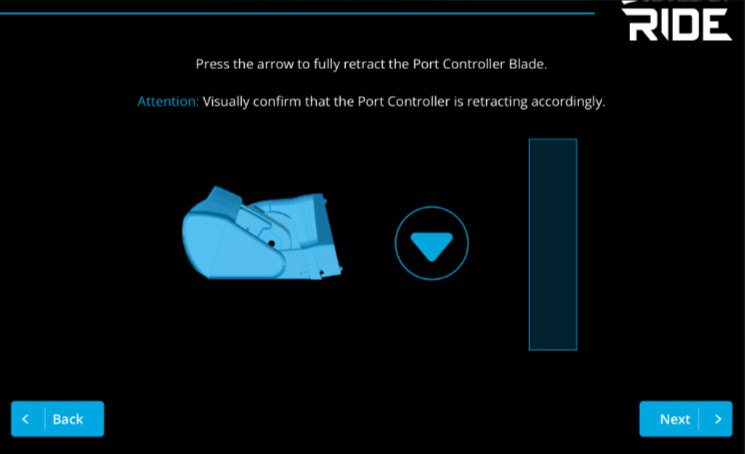
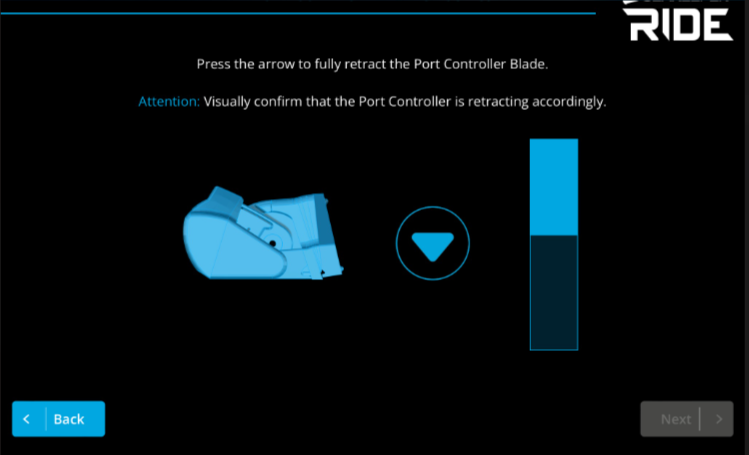
Note: In order to proceed you MUST retract deployment to Zero position in order to select the ‘Next’ button.
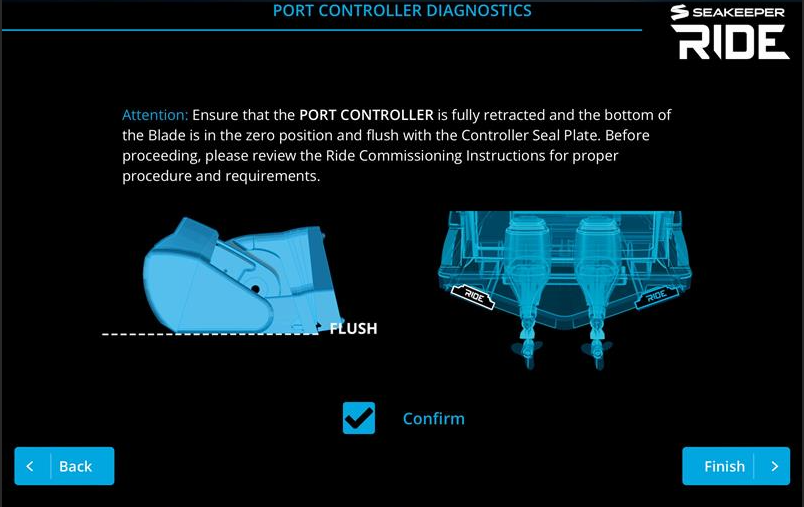
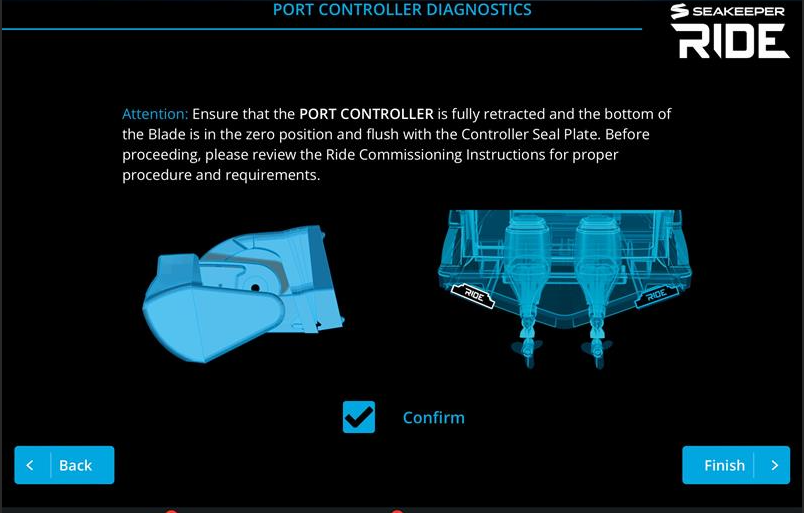
The following screen informs the users about TCC (Trim Command Curve) and where to locate it when setting changes are needed.
Note: Refer to the TCC (Trim Command Curve) instructions here – https://manuals.seakeeper.com/ride/seakeeper-ride-trim-command-curve/
You have now fully Commissioned the Seakeeper Ride system, and it is ready for the water! Press the three-line icon on the bottom right of the MFD screen and select the ‘Home’ icon to return to the home screen and use your Seakeeper Ride system.


Note: The speed of the boat, GPS connection, and the system being in Auto or Manual mode will all influence how Seakeeper Ride behaves. Even if Seakeeper Ride is set up correctly, the Controllers may have limited range based on these factors. Refer to the table below for more information and see the Seakeeper Ride Operation Manual Section 2.1 and Section 2.2 for home screen controls.
If the Seakeeper Ride system has already been commissioned previously, then please follow the Section 4 – Service Menu Items steps to access the Service Menu Items.
4. Service Menu Items
The Service Menu Items can be utilized for adjusting certain parameters of your Seakeeper Ride system.
To access the Service Menu Items, choose the button with three lines on the bottom right of the MFD, then choose tool icon on the bottom right.



ATTENTION! Changing these critical settings can render the system nonfunctional and create an unsafe operating condition. Please proceed only if you have read and understand this manual in full.
Service menu items should be chosen from top to bottom starting with ‘System Status’ to see what needs to be completed. The System Status screen will give an overview of the current Seakeeper Ride settings. It is helpful for troubleshooting and understanding your installation.
Before Service Menu Screens are accessed to make changes, there is a pass code which must be used when accessing these pages due to the risk associated with these procedures.

Note: If equipped with a keypad, the Keypad will be disabled while in all service screens.


ATTENTION! Because of the risk associated with these procedures there is a pass code which must be used when accessing these pages. The pass code is 339037.
System Status
This item indicates if the Configuration (system set up) for your Seakeeper Ride system has been completed. The Configuration Conditions must be satisfied in order for the Seakeeper Ride system to function properly. The Configuration must be handled at the initial installation, and it will show to the operator if it is incomplete. If Seakeeper Ride operation is incorrect, troubleshooting will be necessary to determine and adjust accordingly. The Configuration Conditions screen may help with that but, will not be able to determine the issue.
The following information details each system status screen item, what they mean and how they affect the Seakeeper Ride system.


Attitude Calibration
Attitude Calibration adjusts the sensors in the Seakeeper Ride system to match the detected horizon, providing a target attitude used during Auto Mode operation. Once Seakeeper Ride is in operation, the system will adjust the boat’s attitude to match the horizon as calibrated during this step. It is critical that the boat is on an even keel with no excess bow or stern trim during this step. Please follow prompts on the screen for important details to this calibration. This process takes approximately 1 minute to complete.

ATTENTION! Because of the risk associated with these procedures there is a pass code which must be used when accessing these pages. The pass code is 339037.



Controller Zeroing
When Seakeeper Ride is at rest, the Blade will be up not interrupting water flow behind the seal plate. As the
control system dictates, the Blade rotates down and it creates lift at the transom stabilizing the boat.
Controller Zeroing calibrates the position of the Blade relative to the Seal Plate. Changing this setting can render the system nonfunctional and create an unsafe operating condition. Before proceeding, please review the Operation Manual for proper procedure and requirements.

ATTENTION! Because of the risk associated with these procedures there is a pass code which must be used when accessing these pages. The pass code is 339037.




Controller Zeroing will have a second section located on the second page of the Service Item Menu for the Starboard Controller.
Plug in the Starboard Actuator so that both Actuator Cables are plugged into the Distribution Module.
Note: Repeat the steps above to configure the Starboard Controller.

Diagnostics

WARNING: Diagnostic’s functions do not observe vessel speed, DO NOT attempt to perform Diagnostics when vessel is moving!!
Note: Vessel must be stopped when performing Diagnostics.
Diagnostics will test the mechanical travel, direction of motion, and communication of the Seakeeper Ride system prior to sea trialing. Please pay attention to which Controller side (port or star) you are diagnosing, so the movement of the Controller matches the indicated movement on the Ride App Screen
Note: Diagnostics will be completed twice to check that both Actuators are functioning correctly. If your system has a keypad, the lights will not function during Diagnostics.

ATTENTION! Because of the risk associated with these procedures there is a pass code which must be used when accessing these pages. The pass code is 339037.


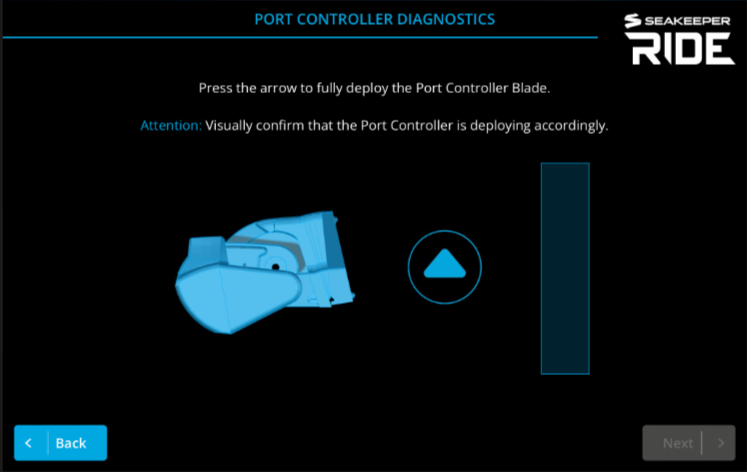

Note: You must fully deploy the Blade before you press Next.
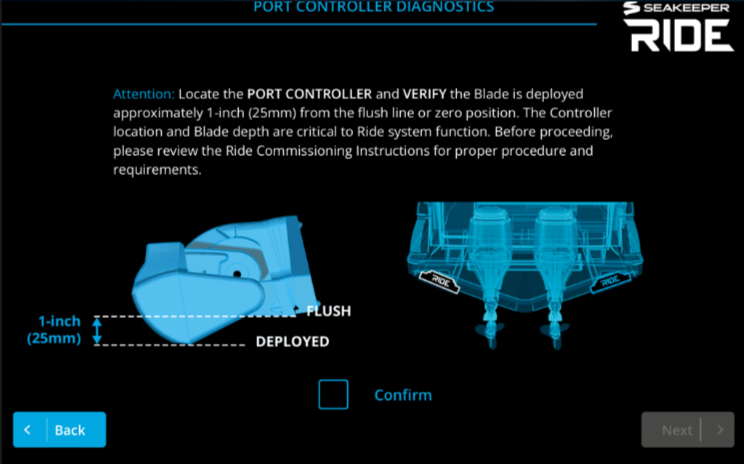
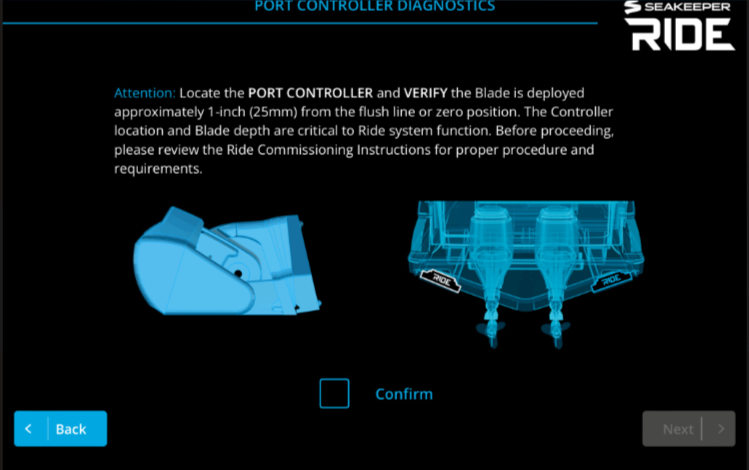
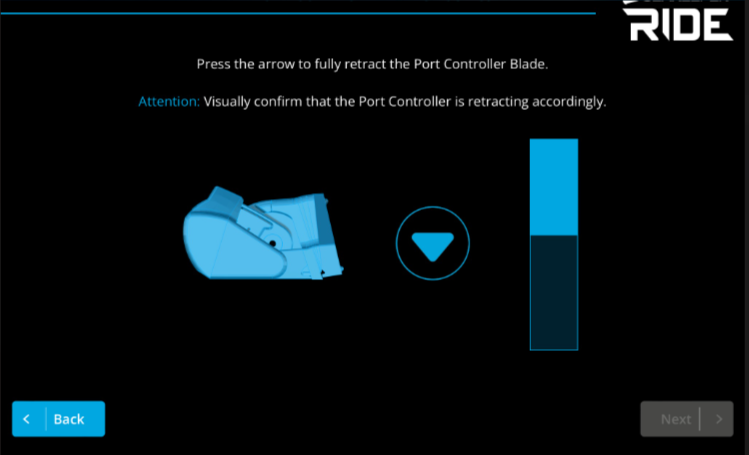

Note: You must retract the Blade fully to its Zero position before you press ‘Next’.
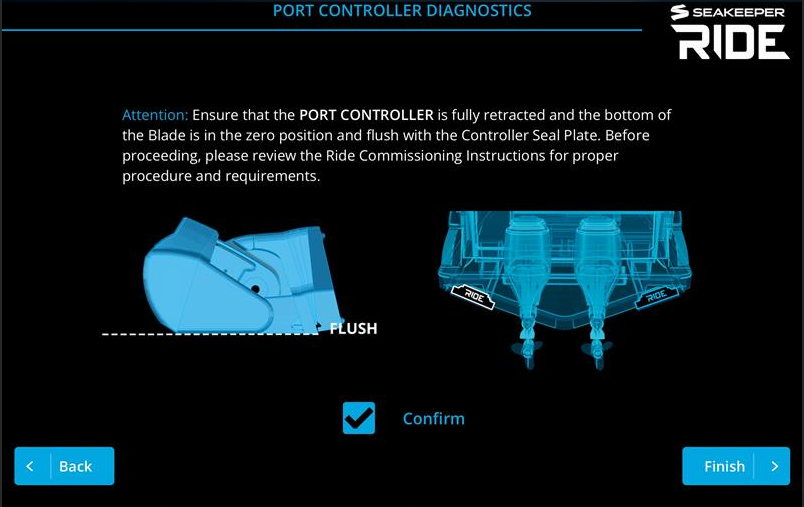
Factory Reset

WARNING: DO NOT UTILIZE THE FACTORY RESET IF FAULT CODES ARE PRESENT!

WARNING: Please be aware a factory reset will result in the Seakeeper Ride equipment not functioning until a full commissioning is completed again.
The Seakeeper Ride Factory Reset feature will wipe the entire Ride system and restore it to factory default settings. By pressing ‘RESET’, the system will restart, and a full reinstallation procedure will be required. This procedure will require access to the Software Module, Distribution Module, knowledge of the cable corresponding to each Controller and the Blades and Seal Plates.

ATTENTION! Because of the risk associated with these procedures there is a pass code which must be used when accessing these pages. The pass code is 339037.


Once you initiate the ‘Factory Reset’ you will follow procedure shown in (Seakeeper Ride | Commissioning Instructions- Section 3) to restore Seakeeper Ride functionality.

Note: The speed of the boat, GPS connection, and the system being in Auto or Manual mode will all influence how Seakeeper Ride behaves. Even if Seakeeper Ride is set up correctly, the Controllers may have limited range based on these factors. Refer to the table below for more information and see the Seakeeper Ride Operation Manual Section 2.1 and Section 2.2 for home screen controls.
If the Seakeeper Ride system has not been commissioned previously, then please follow the Section 3 – First Installation Commissioning steps.
5. Enter Advanced Mode
The following instructions for ‘Advanced Mode’ will remain available for users that have updated their Seakeeper Ride system prior to September 1, 2023. Please update Seakeeper Ride system to the latest Software Update possible at the link listed here. https://ride.seakeeper.com/support/software-updates/
Access Advanced Mode to configure the system components. Configuration will program all components to function together as a complete system. This step must be performed on the first start of the Seakeeper Ride System to make the system operational. Only under extenuating circumstances will the Advanced Mode need to be accessed following the first start. The operator will be able to access configuration settings for:
- Angle Calibration
- IMU Orientation
- Controller Configuration

ATTENTION! The Advanced Mode screen is only to be used when commissioning the Seakeeper Ride system or if configuration was done incorrectly.
- From the Home screen press Settings
 in the bottom right of the MFD.
in the bottom right of the MFD. - Select the Install screen in the top right.

- Select Advanced Mode.

- You will be prompted twice to determine if you wish to proceed. Select Continue both times to access the configuration home screen.
- Even if the Configuration Condition shows Satisfied, the configuration must be completed before the Seakeeper Ride system is operational. See the following steps below.

- To begin the Configuration Mode, select Enabled.

- The Advanced Settings screen will appear.

Note: Both options must be selected before choosing the option you want in order for the system to recognize your selection.
6. Angle Calibration
Angle calibration adjusts the sensors in the Seakeeper Ride system to match the detected horizon, providing a target attitude used during Auto Mode operation. Once the Seakeeper Ride is in operation, the system will adjust the boat’s attitude to match the horizon as calibrated during this step. It is critical that the boat is on an even keel with no excess bow or stern trim during this step. Because of the system’s precision, this step takes up to 1 minute to complete and will directly affect the performance of the system.

Note: Excess motion during this step disrupt calibration. If this is performed on water, it must be especially calm. Movement of passengers on board the boat is unacceptable.
There are two ways to perform the angle calibration, both of which will provide the same result. Follow the steps the steps below to use either the Advanced Settings screen or the Install Screen to complete the angle calibration.
Advanced Settings Screen Angle Calibration
- While in the Advanced Settings screen, select Angle under Angle Calibration Settings.

- Wait 60 seconds for the computer to calibrate. Select Rate. Wait an additional 60 seconds for the computer to calibrate.
Install Screen Angle Calibration
- From the Home Screen, press the Settings
 icon on the bottom right of the display.
icon on the bottom right of the display. - Select the Install screen in the top right of the display.

- Select Angle Calibration.

- You will be asked if you wish to proceed. Press Continue.
- Selecting Angle Calibration again will provide another prompt asking if you wish to proceed. Press Continue again.
- The calibration will begin. Once completed, the Install screen will reappear.
7. IMU Orientation
Note: Both options must be selected before choosing the option you want in order for the system to recognize your selection.
The Inertial Measurement Unit (IMU) provides angle and speed information to the Seakeeper Ride system to allow for dynamic damping of the boat’s motions. The IMU Orientation programs the system to be aware of the IMU’s relation to the boat.

The IMU selections are as follows:
- Fore orientation indicates the logo on the Software Module faces the bow of the boat.
- Aft orientation indicates the logo on the Software Module faces the stern of the boat.
8. Controller Configuration

Controller Configuration will program the Software Module to determine three (3) critical items:
- The side of the boat the Controller is on
- The fully retracted position
- The direction the Controller should move
Note: Both options must be selected before choosing the option you want in order for the system to recognize your selection.
Follow these steps to complete the Controller Configuration:
- Unplug both Controllers from the Distribution Module.
- Plug in the port side Controller to the Distribution Module in either of the Ampseal ports.
- Select Assign.
- In the pop-up window, select Port 1.

- Select Assign.
- Move the Blade such that it is flush with the Seal Plate (right).
- Select Zero.
- Select the Cable Routing Side based on if the Actuator Cable is on the port or starboard side of the Controller.

Example: The port side Controller is shown in the figure. The black cable is routed on the port Cable Routing Side. If the position of the white cable was used, the correct selection would be starboard for the Cable Routing Side.
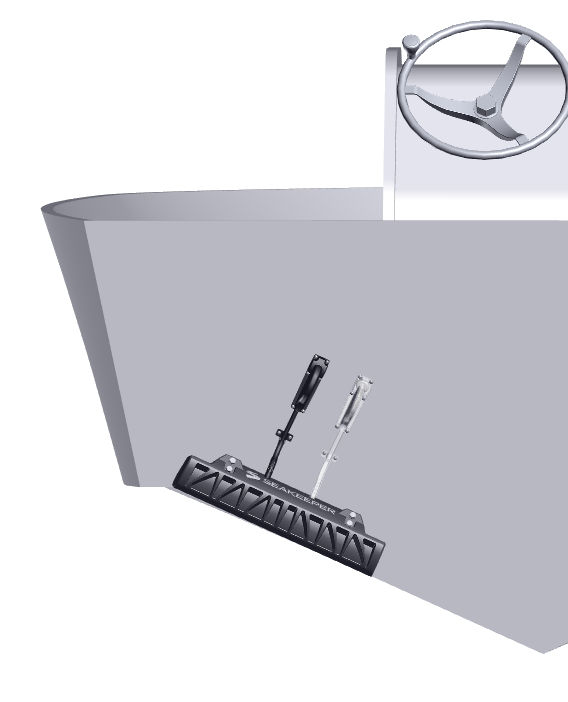
- Unplug the port side Controller from the Distribution Module.
- Repeat steps 2-9 for the starboard Controller. Use the arrows on the screen to alternate between port and starboard after plugging in the Controllers.
- Plug both Controllers into the Distribution Module. To ensure the Controllers are properly connected, gently pull on the cables after plugging them in.
- Once complete, allow 30 seconds for the system to save all data.
9. Exiting Advanced Mode
To exit advanced mode:
- Under Configuration Mode, select Disabled
- Select Exit Advanced.
Rebooting the system after any configuration to make sure all settings are saved and applied.
- Turn the engine key off.
- Wait for at least 30 seconds.
- Turn the engine key on.
10. Testing the System
Once the system has been configured, test that the system is operating correctly. While testing the system, make sure the boat is stationary and has GPS connection. Testing is best done with the boat out of the water, allowing the Controllers to be seen more clearly. If the Seakeeper Ride system does not perform as indicated in any of these steps, return to the previous sections and repeat the associated procedures as necessary.
Note: Pressing the left and right directional arrows move the Blade, blue fill bar, and Keypad lights on the opposite side. For example, pressing the left, or port side, arrow will change the starboard side blue fill bar.
- Enter Manual Mode by pressing the Seakeeper Logo in the center of the directional arrows on the Home Screen of the display or the Keypad.
- Look over the transom of the boat to visually confirm the Controller’s Blades are fully retracted and flush with the Seal Plate.
- Use the up directional arrow to fully deploy the Blades. The blue bars on the screen should be filled in with blue completely. Look over the transom of the boat to verify the Controller Blades have deployed completely.

- Use the down directional arrow to retract the Blades completely.
- Press the right directional arrow until the port side blue bar fills in completely.

- Visually confirm that the port Controller’s Blade is deployed completely.
- Repeat steps 5-6 for the left directional arrow corresponding to the starboard Controller.
The Seakeeper Ride system commissioning is now complete. Please refer to the Quick Start Guide to begin using the Seakeeper Ride system.
Note: The speed of the boat, GPS connection, and the system being in Auto or Manual mode will all influence how Seakeeper Ride behaves. Even if Seakeeper Ride is set up correctly, the Controllers may have limited range based on these factors. Refer to the table below for more information, and see the Seakeeper Ride Operation Manual Section 2.1 and Section 2.2 for home screen controls.
| Auto Mode | Manual Mode | |
|---|---|---|
| Speed (with GPS signal) | ||
| 0-10 mph | Blades can be moved fully together by trimming with the up and down directional arrows. The left and right directional arrows will apply a trim to the system but will not cause the Blades to move at these speeds. The Blades will not move automatically. | Blades can be moved fully with the directional arrows. |
| 10+ mph | Blades will deploy automatically based on movement of the boat and the TCC. At higher speeds, the Blades will deploy less. Blades can also be manually trimmed with the directional arrows. | Blades can be moved fully at lower speeds and will allow less movement at higher speeds. |
| GPS | ||
| Connected, Good Signal | Blades will deploy as described above in the ‘Speed’ section. | Blades can be moved to the maximum range allowed by the speed. |
| No Signal | Auto Mode will be disabled. Fault will be shown on screen. | Blades can be moved with the directional arrows up to 25% deployment regardless of speed. |
11. Trim Command Curve (TCC)
The Trim Command Curve (TCC) allows the operator to set a preferred trim at speeds of 10-50 mph in 5 mph increments. This important feature allows the boat to get on plane significantly faster by deploying the Blades when accelerating. The TCC additionally allows the operator to adjust the attitude of the bow by setting preferred Blade deployment at cruise speeds.

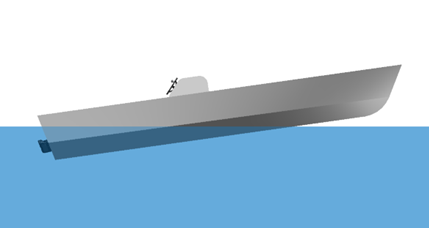
The default TCC setup is designed to work well for all boats equipped with Seakeeper Ride. If Seakeeper Ride is being commissioned at an OEM boat builder and a desired TCC setup is known for a particular model of boat, those settings may be applied at this time. Otherwise, it is recommended to wait to customize the TCC until testing the performance of the boat in the water.
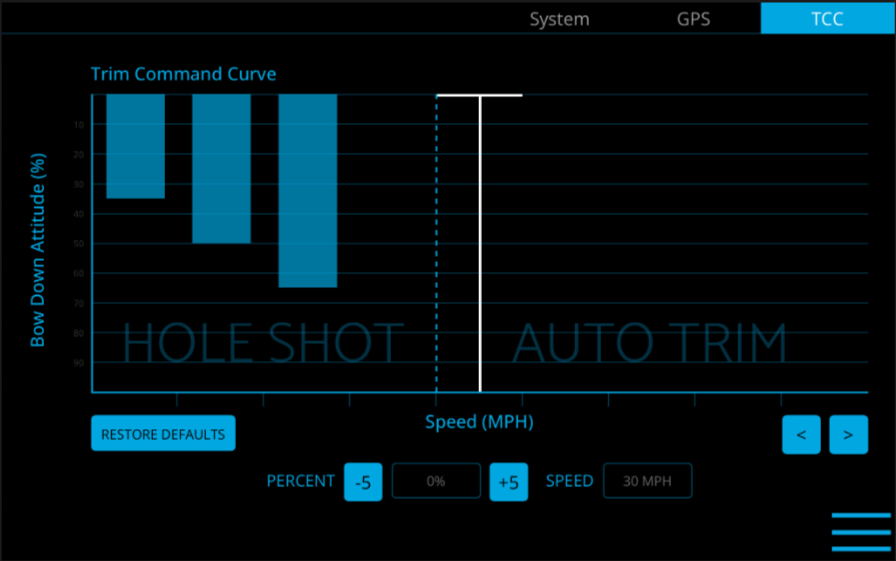
For more information on the TCC and instructions on customization, see Section 3.3 of the Seakeeper Ride Operation Manual.
12. Troubleshooting
If Seakeeper Ride does not operate correctly when testing the system in Section 10 or if the commissioning process is unable to be completed because of a persisting issue, refer to the Seakeeper Ride Troubleshooting Guide for help. Reviewing and correctly following one or more of the previous commissioning sections will often resolve the issue. However, there may be issues resulting from an incorrect electrical installation, which could include, a loose wire, incorrect wiring, missing components, etc. Visit the tables in the Seakeeper Ride Troubleshooting Guide to help identify possible causes of the issue and find the solution.